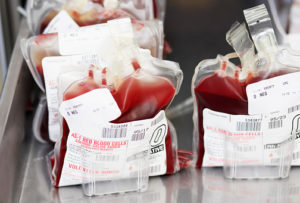Results from the Centers for Disease Control and Prevention 2015 National Blood Collection and Utilization Survey (NBCUS) in the United States show fewer blood donations and transfusions compared to 2011 and 2013 continuing the decline since peaking in 2008. Compared to 2013 data, RBC, platelet and plasma transfusions respectively declined by 13.9%, 13.1%, and 24.8%. The greatest decrease of transfusions occurred in the operating room with 41.5% fewer transfusions. Furthermore, RBC donations decreased by 11.6%, plasma donations decreased by 14.4% and platelet donations remained relatively stable compared to 2013. The number of donors decreased between 2011 and 2015; the majority of donations are from repeat blood donors in 2015 (63.6% of donations). The NBCUS also reported lower prices for leukoreduced RBCs, apheresis platelets, and fresh frozen plasma compared to 2013, which may hinder incorporating new safety measures such as pathogen reduction technology. Survey results suggest that blood collection centers and hospitals have many challenges ahead in order to maintain an adequate and safe blood supply.
References: 1-3
- Ellingson KD, Sapiano MRP, Haass KA, Savinkina AA, Baker ML, Chung KW, Henry RA, Berger JJ, Kuehnert MJ, Basavaraju SV. Continued decline in blood collection and transfusion in the United States-2015. Transfusion 2017;57 Suppl 2: 1588-98.
- Sapiano MRP, Savinkina AA, Ellingson KD, Haass KA, Baker ML, Henry RA, Berger JJ, Kuehnert MJ, Basavaraju SV. Supplemental findings from the National Blood Collection and Utilization Surveys, 2013 and 2015. Transfusion 2017;57 Suppl 2: 1599-624.
- Menitove JE. What is it all about? Transfusion 2017;57 Suppl 2: 1585-7.


I do agree with the survey this is true with many other countries as there is growing tendency about patient blood management
( appropriate & rational use of blood & blood components)
Secondly the phelonthropic attitude towards voluntary blood donation is also fading to some extent